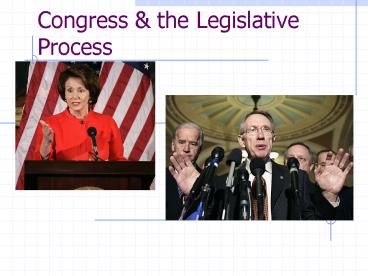Congress - PowerPoint PPT Presentation
1 / 14
Title: Congress
1
Congress the Legislative Process
2
Founders Intentions
- Most powerful branch of government
- It is Article I 18 expressed powers
- Representative assembly
- Accessible to the people
3
Constitutional Powers of Congress
- Establish and maintain the armed forces
- Declare war
- Raise taxes and borrow money
- Spend money for the general welfare
- Regulate interstate commerce
- Do what is "necessary and proper
4
The specific natures of each chamber
- House requirements
- Twenty-five years of age
- Seven years of citizenship
- Two-year term
- Senate Requirements
- Thirty years of age
- Nine years of citizenship
- Six-year term
5
House Structure
- Centralized and relatively organized
- Less debate
- Restricted access to the floor
- Individual members have limited power
- Functions
- Originate all revenue bills
- Agents of local interests
6
Senate Structure
- More regional and national in concerns and
constituencies - The elite house of the legislature - (Senators
appointed by state legislatures until Seventeenth
Amendment) (1913) - More deliberative no time limits on speaking
- Filibuster speak as long as they want to oppose
an action (subject to cloture)
7
Congressional Compositions (106th Congress,
1999-2001)
8
Congressional roles / functions
- Instrument for policy
- Perform constituency service (intervene on behalf
of citizens, help with other requests capitol
tours, tickets to viewing gallery, flags, etc) - Patronage activities provide direct service to
constituents (i.e. pork barrel) - Reward contributors
9
Congressional roles / functions (contd)
- Oversight
- Investigations, hearings.
- Budgeting / fiscal roles
- War funding Ways and Means Committee
10
Congressional behavioral tendencies
- Members of Congress are motivated by re-election
- Distributive tendency pork-barrel legislation
funds local work projects to bring federal money
to the states (earmarks)
11
Committee System
- Core of Congress where bills are considered
- Committees allow members to specialize in policy
areas and become experts - Congressional division of labor achieved through
committees - Committee chairs act as "gatekeepers
- Standing committees have fixed membership,
officers, rules, staff, and offices - Majority party sets rules and chooses officers.
- Majority party always has most committee members
minority party has some. - Jurisdiction is defined by subject matter of
legislation.
12
Internal structure types of committees
- Standing committees permanent important topic
- Conference committees House/Senate differences
in same bill at end of process - Joint committees House/Senate on a common topic
- Select committees temporary set for a special
purpose.
13
Examples of committee jurisdictions
- Farm subsidy bills go to Agriculture Committee
- Highway bills go to Transportation Committee
- GI Bill benefits go to Veterans Affairs Committee
14
How A Bill Becomes Law
Bill Is Introduced in The Senate
Bill Is Introduced in The House
Referred to House Committee
Referred to Senate Committee
Referred to Subcommittee
Referred to Subcommittee
Could be more than one multiple referral
Changes Voted on by Full Committee
Changes Voted on by Full Committee
Full Senate Debate and Vote
Full House Debate and Vote
Conference Committee
House Approves
Senate Approves
If the President signs the bill, it becomes
public law































